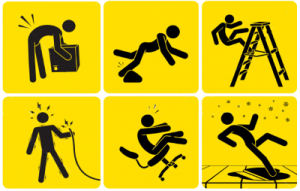What are the most common workplace injuries for manufacturing businesses?
The National Safety Council lists the following injuries, by nature of injury, to be most commonly experienced by workers in the manufacturing industry in the year 2017:
- Sprains, strains, tears (30%)
- Cuts, lacerations, punctures (13%)
- Soreness, pain (12%)
- Fractures (11%)
- Bruises, contusions (7%)
The report investigated a total of 115,853 cases with around 99.7% of the injuries classified as nonfatal. These include the top five injuries such as soreness, sprains, strains, fractures, etc. Sadly, there were 303 incidents of fatal injuries within the same period, equivalent to 0.3% of the total cases observed.
What are the most common causes of workplace injuries?
Workplace injuries are typically classified according to the type of event or exposure that is most closely linked to the injury. Looking at the manufacturing industry alone, the National Safety Council lists the top five causes of injuries to be:
- Contact with objects and equipment (34%)
- Overexertion and other bodily reactions (32%)
- Falls, slips, and trips (18%)
- Repetitive motion (6%)
- Exposure to harmful substances or environments (5%)
How to prevent workplace injuries
A good start would be proactively preparing for the top causes of injuries. For starters, facilities should invest in quality personal protective equipment (PPE). This reduces the risk of being injured from contact with heavy equipment, or even harmful substances. PPE can also extend to the use of safety markers and signages. These physical indicators grab the attention of workers to be cautious when working around more hazardous areas within a facility.
Proper training also equips the team with best practices in working in and around the site. Aside from mandatory safety training in equipment handling, managers can add training and assessment in ergonomics and proper form to address injuries from overexertion, bodily reactions, and repetitive motions that cause stress injuries.
Preventing injuries saves money
Finally, creating a safer workplace is an investment. While there are initial and even maintaining expenses to promote a safer working environment, the benefits certainly outweigh the costs. In 2017, nonfatal workplace injuries amounted to nearly 60 billion USD a year in compensation costs for workers. This highlights the importance of making an effort to avoiding injuries and doing things safely – from the perspectives of both employers and employees.
Want to keep reading?
How can effective safety management actually save money?
What Is Planned Maintenance? | 6 Benefits & Workflow
The Recommended Method of Documenting Preventive Maintenance
4,000+ COMPANIES RELY ON ASSET OPERATIONS MANAGEMENT
Leading the Way to a Better Future for Maintenance and Reliability
Your asset and equipment data doesn't belong in a silo. UpKeep makes it simple to see where everything stands, all in one place. That means less guesswork and more time to focus on what matters.

![[Review Badge] Gartner Peer Insights (Dark)](https://www.datocms-assets.com/38028/1673900494-gartner-logo-dark.png?auto=compress&fm=webp&w=336)

